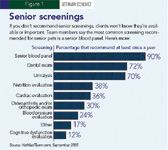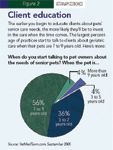Giving older pets complete care
With National Pet Wellness Month around the corner, it's a great time to evaluate how you educate clients about older pets' needs.
BETTER HEALTH CARE MEANS PETS are living longer. And more elderly pets means that senior care is more important than ever. Is your practice team prepared to offer clients a strong recommendation for their older pets?
Fifty-two percent of respondents to a September 2005 VetMedTeam.com survey say their practice training/CE protocols include staff education on the special needs of senior pets. But 87 percent of respondents say they feel they need additional educational opportunities that focus on senior care. And its easy to see the benefit of educating team members when you consider that nearly 31 percent of respondents to the 2006 Veterinary Economics Business Issues Study indicate that a credentialed technician, veterinary assistant, or receptionist spends the most time educating clients about nutrition. And 62 percent of respondents to the VetMedTeam.com survey say their practices recommend geriatric prescription diets for healthy senior pets. So your team definitely helps determine whether your clients buy into the benefits of senior care.
Of course, you have a critical role, too. For instance, 87 percent of respondents to the Business Issues Study say the veterinarian spends more time than anyone in the practice discussing age-related diseases.

Figure 1
No matter how you dole out responsibility for discussing senior care topics, it's important to build time into the visit to communicate the information. Team members devote an average of 15 minutes to each wellness visit, and the doctor spends 12 minutes per visit, according to the study.
If you're not fitting all of the information you'd like to cover into visits, schedule a little more time for senior exams. And develop a specific protocol for your senior care program, so you know who will cover which topics with each client. (See Figure 1 for information on which screenings practices recommend.)
Tools and opportunities
Handouts and posters in the exam room are the most popular educational tools, according to the 2006 Veterinary Economics Business Issues Study. The least popular are videos and the use of the Internet in the exam room. Still, 40 percent of practices are using a Web site to make educational materials available to clients. (For more, see "Client Education on Limited Time".)

Figure 2
You can also take advantage of opportunities, such as National Pet Wellness Month in October and Adopt a Senior Pet Month in November, to spread the word. It's not too late to plan something for this year. And there's always room to improve.